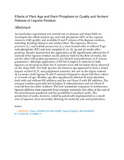Effects of Plant Age and Rock Phosphate on Quality and Nutrient Release of Legume Residue
Date
2009-02Author
ABARCHIae, I.
YuZHANG, Zhan
VANLAUWEb, B.
PingGUOa, Xiang
MuWANGa, Wei
ONG'OR, B.T.I.
TIMBELY, D.
Metadata
Show full item recordAbstract
An incubation experiment was carried out on plateau and slope fields to investigate the effect of plant age and rock phosphate (RP) on the organic resource (OR) quality and available N and P release of the legume residues, including standing biomass and surface litter. The legumes, Mucuna pruriens (L.) and Lablab purpureus (L.), were treated with or without Togo rock phosphate (RP) and were sampled at 12, 18, 24 and 30 weeks after planting. Results showed that the application of RP significantly affected the P content of the legume residues on the plateau field for the first 18 weeks, but not the other OR quality parameters, nor their N mineralization, or P release parameters. Although application of RP led to higher P contents in both legumes on the plateau field, the P contents were still far below those observed on the slope field. For both species, the biomass age appeared to have a major impact on their N, P, and polyphenol contents, but not on the lignin content. At 24 weeks, both legume N and P contents dropped to about half their values at 12 weeks of age. Residue age also significantly affected N mineralization both with and without RP addition and the net Olsen-P with RP addition. The younger residues generally led to higher N mineralization and net Olsen-P content than the older residues. The best immediate responses to herbaceous legume addition were expected from younger materials, but often at the cost of the total biomass produced and the possibility to produce seeds. The production of seeds, however, could be potentially implemented on a small area of legumes, thus invariably allowing for maturity and seed production.
URI
https://doi.org/10.1016/S1002-0160(08)60086-7https://www.sciencedirect.com/science/article/abs/pii/S1002016008600867#!
http://r-library.mmust.ac.ke/123456789/1692
Collections
- Gold Collection [1026]

